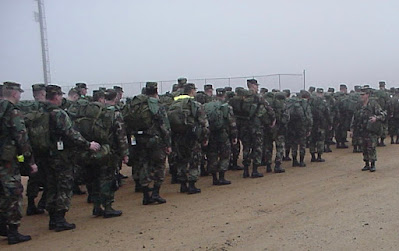This week I watched the televised accounts of the fall of Damascus and the overthrow of the Assad regime with interest and a considerable level of emotion. The scenes all reminded me of the fall of Baghdad in April 2003.
 |
| Iraqis gathered around the ruined status of Saddam in Firdos Square, Baghdad, on April 13, 2004 |
On April 9, 2003, in a spectacle that was televised throughout the world, the Iraqi populace, with some help from the U.S. Marines, toppled a statue of Saddam Hussein in Firdos Square in central Baghdad. On April 14, 2003, 5 days later, I arrived at the Palestine Hotel overlooking Firdos Square to find the remains of the statue. The details of my trip and visit to Baghdad are described in my memoir of the Iraq war, Messages from Babylon.
Several televised news accounts from Damascus got my attention. The first was an interview with some police officers in Damascus who were directing traffic. The regime police, along with their army, had melted away after the lightning overthrow of the government. The interviewed police officers, wearing police uniforms, said that they had recently been brought in from rebel held areas. This wasn’t a spontaneous action. The introduction of outside police and the use of the rebel forces to secure government buildings was planned.
I think when the rebels started the offensive they knew that the regime would fall and they made preparations to assume control of the city and provincial governments.
Contrast that to how the U.S. military assumed control of Baghdad in April 2003. I was one of about 1,500 U.S. Army Civil Affairs Reservists who were mobilized and sent to Ft. Bragg, NC in February 2003. I assumed - we all assumed - that our mission was to be part of a military government of the populace when the Saddam regime was overthrown.
 |
| Members of my unit in Ft. Bragg, NC in March 2004 preparing to deploy to Iraq. |
We also knew that this wasn’t going to be like the 1991 Gulf War, when the U.S. military occupied the southern half of the country but left Baghdad unoccupied and Saddam still in charge. Saddam, part of the Sunni minority that ran the country, used his military to slaughter the Shia uprising that was a consequence of our invasion. I read the U.S. invasion plan and our mission was to enter the country and remove the Saddam regime.
The invasion plan had scant information about what we were supposed to do once Baghdad fell. When I arrived in Ft. Bragg we searched for information about what we were supposed to do once we got to Iraq. From somewhere I obtained a U.S. Army plan, dated December 1944, for the occupation of Germany. This was a good plan, with a lot of specifics actions to be taken by the occupying forces.
“This is great,” I thought. “Why don’t we use this?”
In contrast to what happened in Damascus, when Baghdad fell the Iraqi populace invaded and destroyed the principal government ministry buildings. The institutional memory of how to administer the country was eliminated. This was an inauspicious beginning to our stay in Iraq.
The BBC carried an interview with the new provincial governor in Damascus. He was a civil engineer who had been a part of the resistance for ten years. He had a plan of action. A civil servant who had worked in that office for 28 said that she had never been in the provincial governor’s office until this new governor had arrived.
Within a week of the overthrow of the Assad regime, the schools were reopened. This was another example of the forethought of the resistance. Why had the Syrian resistance done so well when they had so little? Why had we done so poorly when we had so much?
After the war I read a lot of memoirs of the senior administration officials in an effort to discover why we weren't prepared for what happened when Baghdad fell. The answer was disheartening, and the topic for another post.
I don't know what's going to happen in Syria now that Assad is gone. At least the resistance planned for what needed to happen after Damascus fell. They may have a chance to make it.

